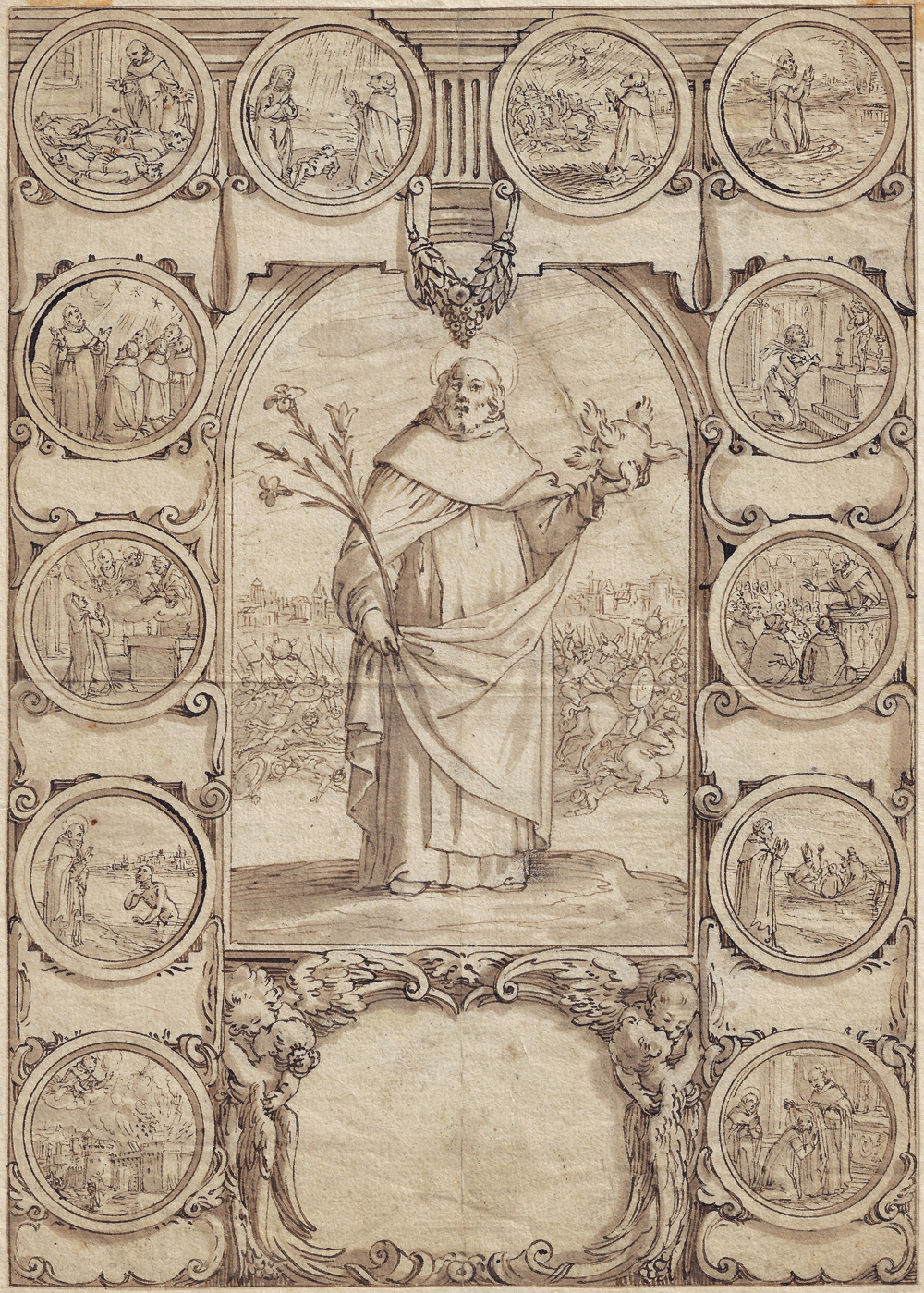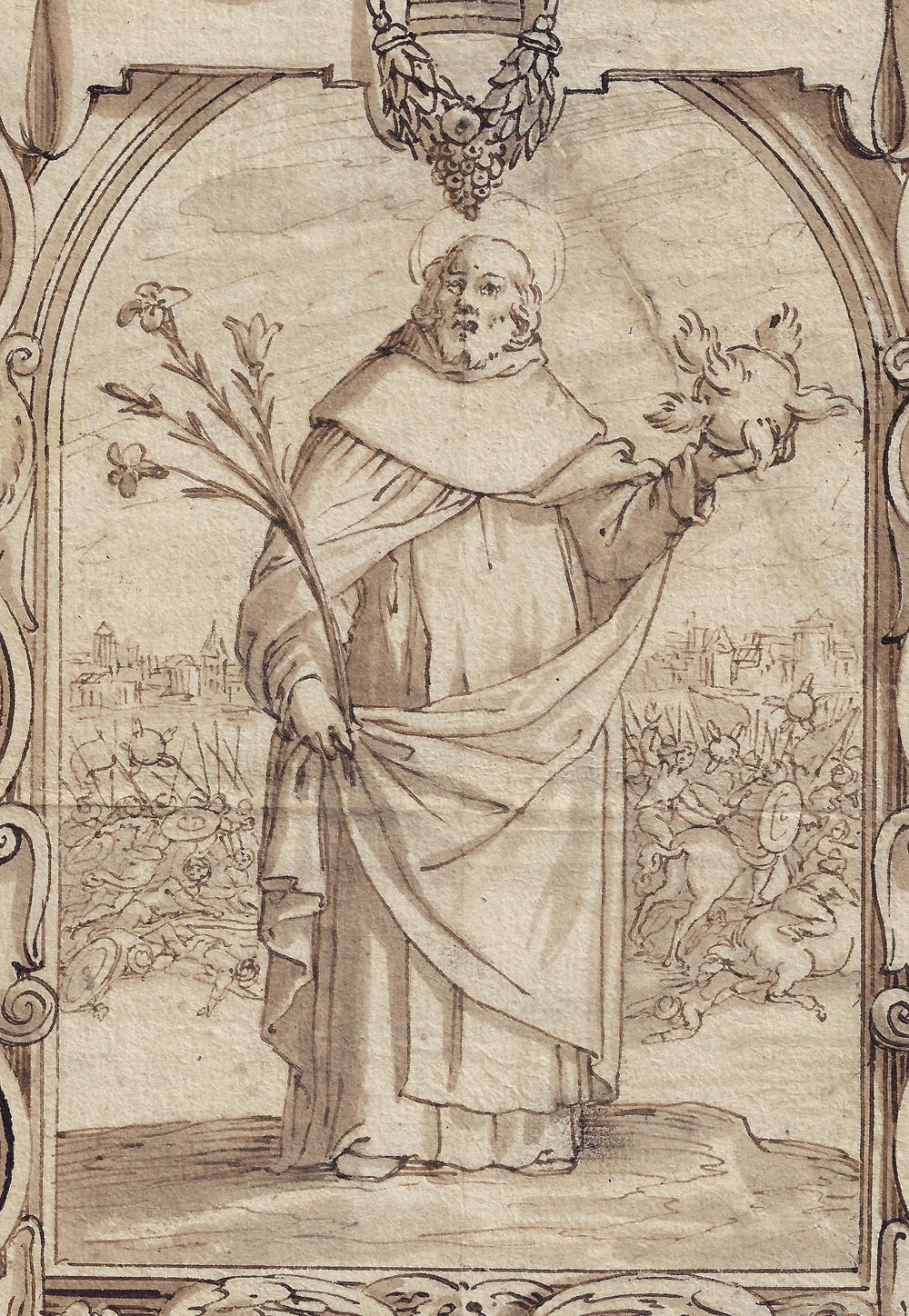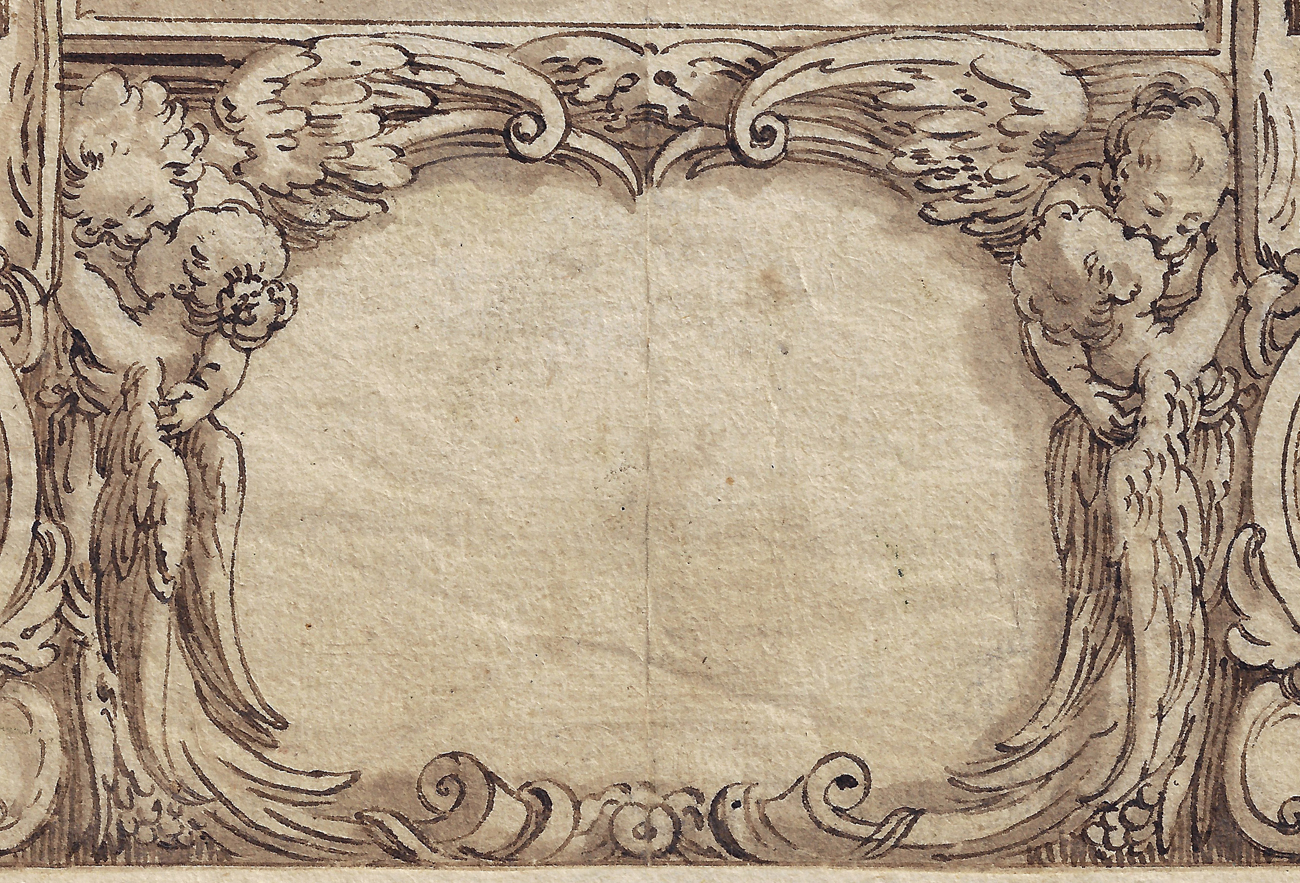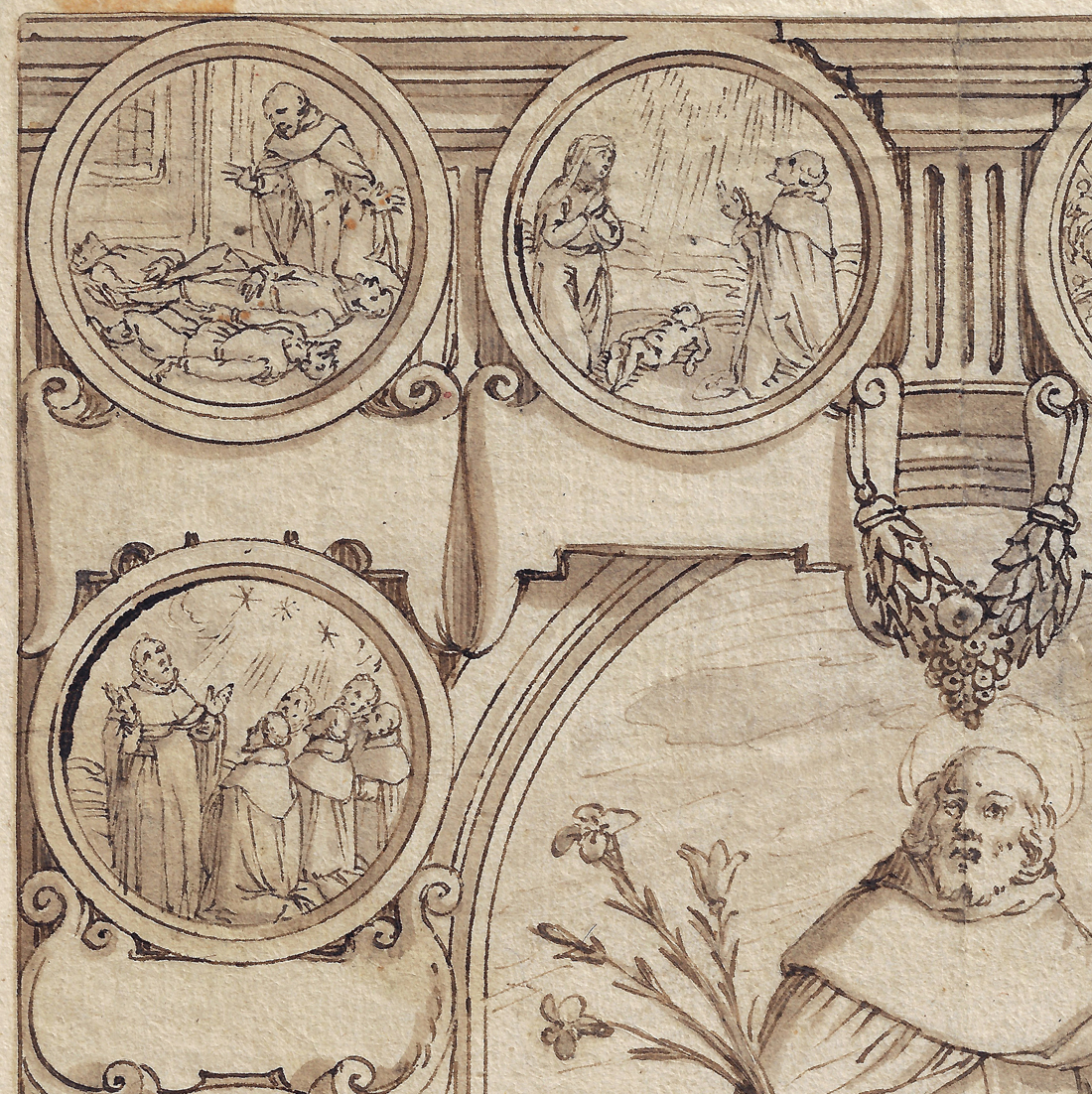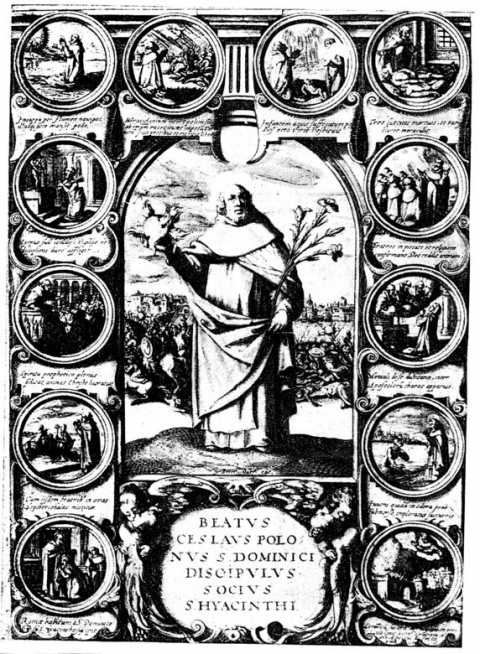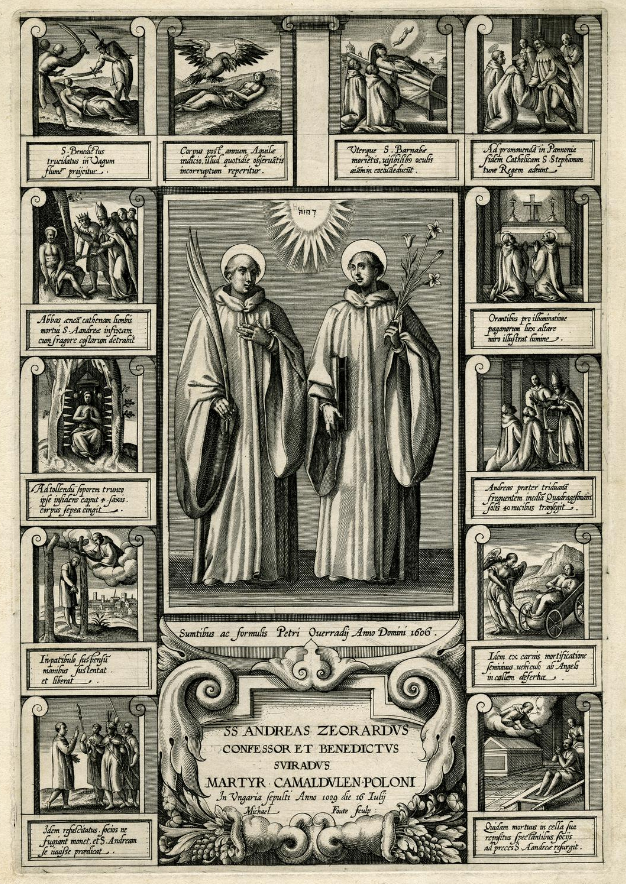PIETER DE JODE I (Antwerp 1573 – 1634 Antwerp)
Pieter de Jode I (Antwerp 1573 – 1634 Antwerp)
St Ceslas of Poland with scenes from his life in the border, design for an engraving
Pen and brown ink, brown wash, brown ink framing lines, watermark snake around staff, 288 x 205 mm (11.3 x 8.1 inch), laid down onto 17th-century supporting sheet
Provenance
Private collection, Italy
Engraved
Engraving (probably by Michel Faulte, active c.1605-1638) published by Peter Overraat (active c.1600-1620) for the series Icones et miracula sanctorum Poloniae, Cologne 1605-06
***
Pieter de Jode was born as the son of Gerard de Jode (c.1517–1591) of Nijmegen, who had settled in Antwerp as printmaker and publisher by 1547.1 According to Carel van Mander’s Schilder-boeck of 1604, Pieter was taught by Hendrick Goltzius, presumably in the late 1580s or early 1590s. Around 1595 De Jode travelled to Siena, Venice, Rome and Paris. He became a member of the Antwerp guild of St Luke in 1600 as ‘plaatsnijder’ (engraver), and married Suzanna Verhulst in 1602, the sister-in-law of Jan Brueghel the Elder and niece of Pieter Coecke van Aelst.
De Jode is mostly known as an engraver and publisher. During his Italian sojourn he engraved models by Francesco Vanni, Titian and Jacopo Bassano. Upon his return to Antwerp he worked for the publisher Christoffel Plantijn, engraving after designs by Sebastiaen Vrancx, Otto van Veen, Rubens and Van Dyck. He also made prints after drawings by Adriaen van de Venne for Jacob Cats’s Houwelick of 1625. De Jode must also have drawn many designs himself, which were engraved either by himself or by other printmakers.2 Many engravings however did not credit the name of the designing draftsman, and De Jode’s activity in this field is likely to be much more significant than currently known – only a few dozen drawings by him have been recognised.3
This large and important sheet is a rare drawing by De Jode for which the engraving has been identified, drawn in De Jode’s typical ‘precise, rather dry’ manner.4 The print was published by Peter Overraat (active c.1600-1620) for the series Icones et miracula sanctorum Poloniae, published in Cologne in 1605-06.5 Overraat was an engraver, book publisher and copperplate dealer in Cologne.6 His publishing house produced, among other works, graphics with images of saints, as for instance on the occasion of their canonization. He cooperated with various artists, including Augustin Braun who also contributed on the present series of Polish saints, consisting of thirteen sheets. In the preparation of drawings and the performing of the engravings produced by Overraat, many artists participated, including De Jode. In all probability, the engravings were commissioned by King Sigismund III Vasa. They are all made according to an uniform model: in the centre is a representative image of the saint, and around it, in a decorative border of scrollwork there are ten to twelve vignettes illustrating the hagiographical legend. The engraving was probably made by Michel Faulte (active c.1605-1638), who was also responsible for other sheets in the series, such as the print of Saints Andreas Zeorardus and Benedictus Suiradus (fig.).7 One other drawing by De Jode for an engraving in the series is known, preserved in the Louvre.8
Ceslas was born in 1180 near Opole and died on 15th July 1242 in Wroclaw. Together with his younger brother St Hyacinthus, he was schooled by St Dominicus himself and was head of the Dominican order in Poland. He founded the Dominican monastery of Wroclaw in 1224 and the successful revolt of the Polish natives against the invading Mongols is credited to his heavenly intervention. His relics are preserved in the church of St Adalbertus in Wroclaw. In our drawing he is shown with his attributes, a branch of lilies and a flaming cannon ball.
SOLD
1. For the artist, see the biography by C. van Mulders in Jane Turner (ed.), The Dictionary of Art, London 1996, vol. 17, pp. 598-99 and Saur Allgemeines Künstlerlexikon: die bildenden Künstler aller Zeiten und Völker, Munich 1992–, vol. 78, pp. 118-19.
2. Hollstein, IX, p. 209 lists engravings by other artists after designs by De Jode.
3. As observed by Marijn Schapelhouman in his Netherlandish Drawings circa 1600, Catalogue of Dutch and Flemish Drawings in the Rijksmuseum, The Hague 1987, p. 60.
4. As characterised by Schapelhouman, op. cit., p. 61.
5. See M. Macharska, ‘Seriarycin Icones et Miracula Sanctorum Poloniae – próba wyjaśnienia genezy’ [the series of engravings Icones et Miracula Sanctorum Poloniae – an attempt to explain its genesis], Roczniki Biblioteki Polskiej Akademii Nauk w Krakowie, vol. 13, 1967, p. 18.
6. See R. Knapinski, ‘The so-called Cologne series of prints Icones et Miracula Sanctcorum Poloniae produced by Peter Overadt’s publishing house’, Barok. Historia – Literatura –Sztuka, vol. 14, 2007, pp. 49-70.
7. An impression is preserved in the Department of Prints and Drawings of the British Museum in London, inv. no. 1862,0208.62.
8. The drawing depicts six central saints, again with images of scenes from their lives in the decorated border, pen and ink, brown wash, 285 x 199 mm, Musée du Louvre, inv. no. 20011.
